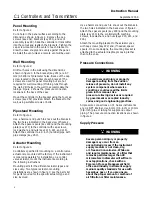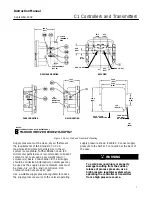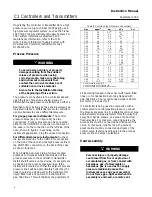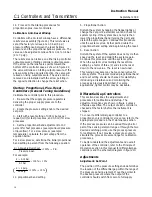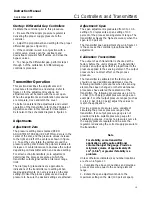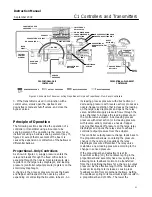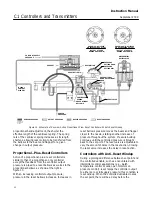
C1 Controllers and Transmitters
Instruction Manual
September 2009
20
IF OUTPUT IS:
MOVE ADJUSTER
LEFT
MOVE ADJUSTER
RIGHT
NOTE:
3 TO 15 PSIG (0.2 TO 1.0 BAR) OUTPUT SHOWN.
FOR 6 TO 30 PSIG (0.4 TO 2.0 BAR) OUTPUT, ADJUST
VALUES AS APPROPRIATE.
A6156 / IL
ABOVE
15 PSIG
(1.0 BAR)
BELOW
15 PSIG
(1.0 BAR)
Figure 12. Transmitter Span Adjustment
3. Verify that the calibration adjuster screws
(key 48) are at mid
−
position in the calibration
adjuster (key 36) slots.
Depending upon the transmitter action, perform one
or the other of the following procedures.
For reverse
−
acting transmitters:
4. Rotate the zero adjustment knob to zero.
5. Apply an input pressure equal to the sensing
element upper range limit.
6. Adjust the nozzle (key 57) until the transmitter
output pressure is at 0.2 bar (3 psig).
7. Set the input pressure equal to zero.
Note
Proper transmitter response depends
on nozzle
−
to
−
flapper alignment.
When performing the span adjustment
in step 8, carefully loosen both
calibration adjuster screws while
holding the calibration adjuster in
place. Then move the calibration
adjuster slightly in the required
direction by hand or using a
screwdriver. Verify proper
nozzle
−
to
−
flapper alignment and hold
the calibration adjuster in place while
tightening both adjustment screws.
8. If the output pressure is not 15 psig, adjust the
span by loosening the two adjusting screws (key 48)
and moving the calibration adjuster (key 36) a small
distance as indicated in figure 12.
9. Repeat steps 4 through 8 until no further
adjustment is necessary.
10. Proceed to the startup procedure for
transmitters.
For direct
−
acting transmitters:
4. Rotate the zero adjustment knob to zero.
5. Set the input pressure to zero.
6. Adjust the nozzle (key 54) until the transmitter
output pressure is at 0.2 bar (3 psig).
7. Apply an input pressure equal to the sensing
element upper range value.
Note
Proper transmitter response depends
on nozzle
−
to
−
flapper alignment.
When performing the span adjustment
in step 8, carefully loosen both
calibration adjuster screws while
holding the calibration adjuster in
place. Then move the calibration
adjuster slightly in the required
direction by hand or using a
screwdriver. Verify proper
nozzle
−
to
−
flapper alignment and hold
the calibration adjuster in place while
tightening both adjustment screws.
8. If the output pressure is not 15 psig, adjust the
span by loosening the two adjusting screws (key 48)
and moving the calibration adjuster (key 36) a small
distance as indicated in figure 12.
9. Repeat steps 4 through 8 until no further
adjustment is necessary.
10. Proceed to the startup procedure for
transmitters.
Startup: Transmitters
1. Be sure that the supply pressure regulator is
delivering the proper supply pressure to the
transmitter.
2. Refer to the calibration procedures for the
transmitter initial settings.

